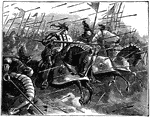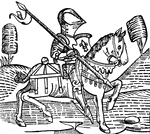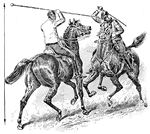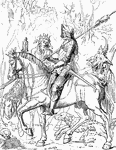Clipart tagged: ‘lance’

Knight Riding Horse & Holding a Lance
An illustration of a knight riding a horse and holding a lance.

Knights Charging with Lances
An illustration of a group of knights charging on horseback with lances.

Two Knights Jousting with Lances
An illustration of two knights jousting with lances, shields, and armor.
Bedouin Lance Heads
"The Lance is a weapon consisting of a long shaft with a sharp point, much used, particularly before…
Bedouin Lance Heads
"The Lance is a weapon consisting of a long shaft with a sharp point, much used, particularly before…

Pennons
"PENNONS. Small flags borne at the end of a lance of an esquire or gentleman bearing his paternal arms.…

Wood Engraving
"A reduced copy of the 'Knight,' and is interesting as one of the first wood-engravings executed in…



